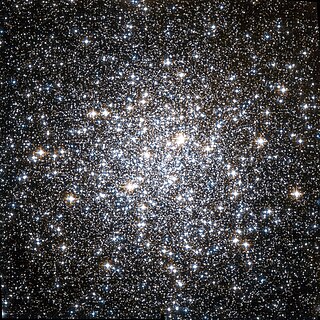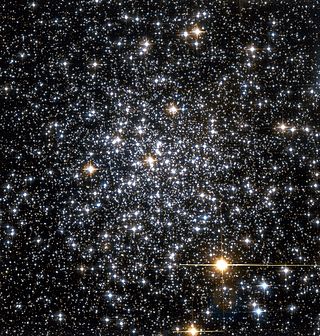
Messier 107 or M107, also known as NGC 6171, is a very loose globular cluster in a very mildly southern part of the sky close to the equator in Ophiuchus, and is the last such object in the Messier Catalogue.

Messier 2 or M2 is a globular cluster in the constellation Aquarius, five degrees north of the star Beta Aquarii. It was discovered by Jean-Dominique Maraldi in 1746, and is one of the largest known globular clusters.

Messier 15 or M15 is a globular cluster in the constellation Pegasus. It was discovered by Jean-Dominique Maraldi in 1746 and included in Charles Messier's catalogue of comet-like objects in 1764. At an estimated 12.5±1.3 billion years old, it is one of the oldest known globular clusters.

Messier 53 is a globular cluster in the Coma Berenices constellation. It was discovered by Johann Elert Bode in 1775. M53 is one of the more outlying globular clusters, being about 60,000 light-years (18.4 kpc) light-years away from the Galactic Center, and almost the same distance from the Solar System. The cluster has a core radius (rc) of 2.18 pc, a half-light radius (rh) of 5.84 pc, and a tidal radius (rtr) of 239.9 pc.

Messier 55 is a globular cluster in the south of the constellation Sagittarius. It was discovered by Nicolas Louis de Lacaille in 1752 while observing from what today is South Africa. Starting in 1754, Charles Messier made several attempts to find this object from Paris but its low declination meant from there it rises daily very little above the horizon, hampering observation. He observed and catalogued it in 1778. The cluster can be seen with 50 mm binoculars; resolving individual stars needs a medium-sized telescope.

Messier 56 is a globular cluster in the constellation Lyra. It was discovered by Charles Messier in 1779. It is angularly found about midway between Albireo and Sulafat. In a good night sky it is tricky to find with large (50–80 mm) binoculars, appearing as a slightly fuzzy star. The cluster can be resolved using a telescope with an aperture of 8 in (20 cm) or larger.

Messier 62 or M62, also known as NGC 6266, is a globular cluster of stars in the south of the equatorial constellation of Ophiuchus. It was discovered in 1771 by Charles Messier, then added to his catalogue eight years later.

Messier 70 or M70, also known as NGC 6681, is a globular cluster of stars to be found in the south of Sagittarius. It was discovered by Charles Messier in 1780. The famous comet Hale–Bopp was discovered near this cluster in 1995.

NGC 4833 is a globular cluster discovered by Abbe Lacaille during his 1751-1752 journey to South Africa, and catalogued in 1755. It was subsequently observed and catalogued by James Dunlop and Sir John Herschel whose instruments could resolve it into individual stars.

NGC 3201 is a low galactic latitude globular cluster in the southern constellation of Vela. It has a very low central concentration of stars. This cluster was discovered by James Dunlop on May 28, 1826 and listed in his 1827 catalogue. He described it as "a pretty large pretty bright round nebula, 4′ or 5′ diameter, very gradually condensed towards the centre, easily resolved into stars; the figure is rather irregular, and the stars are considerably scattered on the south".

NGC 6723 is a globular cluster in the constellation Sagittarius. Its magnitude is given as between 6 and 6.8, and its diameter is between 7 and 11 arcminutes. It is a class VII cluster with stars of magnitude 14 and dimmer. It is near the border of Sagittarius and Corona Australis.

NGC 6760 is a globular cluster in the constellation Aquila. It may have contributed to the formation of the open cluster Ruprecht 127 during NGC 6760's passage through the galactic disk 71 million years ago.

NGC 6934 is a globular cluster of stars in the northern constellation of Delphinus, about 52 kilolight-years distant from the Sun. It was discovered by the German-born astronomer William Herschel on 24 September 1785. The cluster is following a highly eccentric orbit through the Milky Way along an orbital plane that is inclined by 73° to the galactic plane. It may share a common dynamic origin with NGC 5466. As of 2018, it has been poorly studied.

NGC 2808 is a globular cluster in the constellation Carina. The cluster belongs to the Milky Way, and is one of our home galaxy's most massive clusters, containing more than a million stars. It is estimated to be 12.5-billion years old.

NGC 1851 is a relatively massive globular cluster located in the southern constellation of Columba. Astronomer John Dreyer described it as not very bright but very large, round, well resolved, and clearly consisting of stars. It is located 39.5 kilolight-years from the Sun, and 54.1 kilolight-years from the Galactic Center. The cluster is following a highly eccentric orbit through the galaxy, with an eccentricity of about 0.7.

NGC 1261 is a globular cluster of stars in the southern constellation of Horologium, first discovered by Scottish astronomer James Dunlop in 1826. The cluster is located at a distance of 53 kilolight-years from the Sun, and 59 kilolight-years from the Galactic Center. It is about 10.24 billion years old with 341,000 times the mass of the Sun. The cluster does not display the normal indications of core collapse, but evidence suggests it may have instead passed through a post core-collapse bounce state within the past two billion years. The central luminosity density is 2.22 L☉·pc−3, which is low for a globular cluster. Despite this, it has a Shapley–Sawyer Concentration Class of II, indicating a dense central concentration.

NGC 6352 is a globular cluster of stars in the southern constellation of Ara, located approximately 18.3 kly from the Sun. It was discovered by Scottish astronomer James Dunlop on May 14, 1826. The cluster has a Shapley–Sawyer Concentration Class of XI:. A telescope with a 15 cm (5.9 in) aperture is required to resolve the stars within this loose cluster.

NGC 6496 is a globular cluster which is in the direction of the Milky Way's galactic bulge based on observations collected with the WFPC2 on board the Hubble Space Telescope. NGC 6496 was originally believed to be a member of the disc system of the Galactic Center, but scientists questioned this classification. It was instead suggested that NGC 6496, together with two other clusters, NGC 6624 and NGC 6637, could be halo clusters with strongly inclined orbits. NGC 6496 lies in the Southern sky at RA=17:59:03.68 and Dec=-44:15:57.4.

NGC 6541 is a globular cluster in the southern constellation of Corona Australis. It is estimated to be around 14 billion years old.

NGC 5286 is a globular cluster of stars located some 35,900 light years away in the constellation Centaurus. At this distance, the light from the cluster has undergone reddening from interstellar gas and dust equal to E(B – V) = 0.24 magnitude in the UBV photometric system. The cluster lies 4 arc-minutes north of the naked-eye star M Centauri. It was discovered by Scottish astronomer James Dunlop, active in Australia, and listed in his 1827 catalog.





















